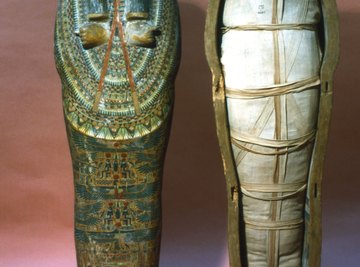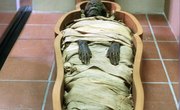
The ancient Egyptian practice of mummification may appear to be a bizarre fascination with death at first glance, but the rituals and belief system were deeply important within their society. The Egyptian religion held a firm expectation of an afterlife, and rites surrounding mummification grew more complex as the civilization progressed. The remains of ancient mummies have revealed ancient Egyptian customs, methods and way of life.
The Purpose of Mummification
Ancient Egyptians from commoners to kings expected that a life after death awaited them. Pharaohs believed their royal divinity ensured them an honored place among the gods, even joining the sun god Re as stars, while commoners came to believe in a new, blessed life of bountiful harvests in the "Field of Reeds." Egyptians believed that preserving the dead body well was crucial -- the deceased person's soul, which underwent judgment in the underworld, also needed to recognize its former home in order to return to it, thus ensuring continued existence in the afterlife.
Developing Methods
In pre-dynastic times, Egyptians buried their dead in the desert where the heat and dryness combined to cause a natural sort of mummification. The earliest known mummification effort was unearthed in the First Dynasty tomb of King Djer by British archaeologist Flinders Petrie, who found part of a bandage-wrapped arm dated to roughly 3000 B.C. Early mummies were wrapped in linen soaked with a liquid resin or plaster that would dry and maintain the shape of the body, particularly the face, in order to appear as lifelike as possible for the returning spirit of the deceased. Once hardened, the molded form could be painted to further resemble the individual.
Sophisticated Techniques
Through 2,000 years of history, ancient Egyptian embalmers developed and refined their processes to improve preservation of the body, much of which involved extracting as much moisture as possible from the corpse to avoid putrefaction. One measure was to remove all internal organs except the heart, considered too important to the person's essence and identity. Another was to use a natural salt called natron that would dry out the flesh. For a centuries in Egypt, the removed organs would be dried and mummified separately, and placed in special jars to be entombed with the remains. Later embalmers developed a technique of mummifying the organs and replacing them in the body before burial.
Embalming
Egyptian embalmers were priests as well as specialized craftsmen and their mummification work involved religious practices, such as reciting prayers during various steps of the process. Embalmers needed sophisticated knowledge of anatomy because the cutting and extractions involved in their work could easily disfigure the body if done incorrectly. The brain, which unlike other organs was discarded, was extracted through the nose using a special hooked instrument. Once the organs were removed, embalmers would clean the corpse with palm wine and spices, which probably helped fight the smell of decomposition. They would pack the body inside and out with natron to dry it, and this process took about 40 days.
Purification
The now-dessicated corpse would be washed again, using water from the Nile. The embalmers would then pack the body cavity with sawdust or linen soaked in resin to ensure it retained a natural shape, then rub the entire surface of the cadaver with a mix of gums, waxes, oils and more natron, and then a dusting of spices. The final stage involved wrapping the mummy in hundreds of yards of linen strips. The embalmer-priests would also place amulets within the wrappings to protect the deceased in the afterlife, and sometimes fit the face with a mask of the person in life. This deluxe process took 70 days to complete and was reserved for royalty and the wealthy, while commoners would settle for less elaborate treatments that varied according to what they could afford, such as flushing out the internal organs with an enema of solvent fluid.
References
About the Author
DaVaun Sanders' passion for writing hails back to the summer of 2002. He writes regularly for PhxSoul.com, is a New America Media Ethnic Elders Fellow and is currently editing his first novel. Sanders holds a bachelor's degree in architecture from Washington University.
Photo Credits
Photos.com/Photos.com/Getty Images
